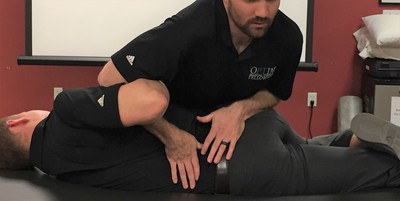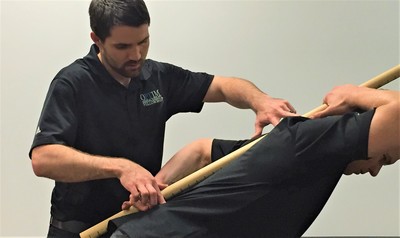- Home
- About Us
- TSPT Academy
- Online Courses
-
Resources
- Newsletter
- Business Minded Sports Physio Podcast
- Day in the Life of a Sports PT
- Residency Corner
-
Special Tests
>
-
Cervical Spine
>
- Alar Ligament Test
- Bakody's Sign
- Cervical Distraction Test
- Cervical Rotation Lateral Flexion Test
- Craniocervical Flexion Test (CCFT)
- Deep Neck Flexor Endurance Test
- Posterior-Anterior Segmental Mobility
- Segmental Mobility
- Sharp-Purser Test
- Spurling's Maneuver
- Transverse Ligament Test
- ULNT - Median
- ULNT - Radial
- ULNT - Ulnar
- Vertebral Artery Test
- Thoracic Spine >
-
Lumbar Spine/Sacroiliac Joint
>
- Active Sit-Up Test
- Alternate Gillet Test
- Crossed Straight Leg Raise Test
- Extensor Endurance Test
- FABER Test
- Fortin's Sign
- Gaenslen Test
- Gillet Test
- Gower's Sign
- Lumbar Quadrant Test
- POSH Test
- Posteroanterior Mobility
- Prone Knee Bend Test
- Prone Instability Test
- Resisted Abduction Test
- Sacral Clearing Test
- Seated Forward Flexion Test
- SIJ Compression/Distraction Test
- Slump Test
- Sphinx Test
- Spine Rotators & Multifidus Test
- Squish Test
- Standing Forward Flexion Test
- Straight Leg Raise Test
- Supine to Long Sit Test
-
Shoulder
>
- Active Compression Test
- Anterior Apprehension
- Biceps Load Test II
- Drop Arm Sign
- External Rotation Lag Sign
- Hawkins-Kennedy Impingement Sign
- Horizontal Adduction Test
- Internal Rotation Lag Sign
- Jobe Test
- Ludington's Test
- Neer Test
- Painful Arc Sign
- Pronated Load Test
- Resisted Supination External Rotation Test
- Speed's Test
- Posterior Apprehension
- Sulcus Sign
- Thoracic Outlet Tests >
- Yergason's Test
- Elbow >
- Wrist/Hand >
- Hip >
- Knee >
- Foot/Ankle >
-
Cervical Spine
>
- I want Financial Freedom
- I want Professional Growth
- I want Clinical Mastery
Gillet Test
Purpose: To assess mobility limitation in the sacroiliac region.
Test Position: Standing.
Performing the Test: The examiner palpates the inferior aspect of the PSIS of the tested side with one hand and the S2 spinous process with the other. The patient flexes the hip past 90 degrees. The examiner should feel the PSIS move inferiorly and laterally relative to the sacrum. A positive test is when this motion is absent. The examiner should then compare this to the opposite side. An alternate method for this test is to palpate both PSIS's at the same time and compare the end position.
Diagnostic Accuracy: Kappa (at best) = .081 ("Intraexaminer and Interexaminer of the Gillet Test"; the Gillet test has extremely low reliability) Sensitivity: .08; Specificity: .93 ("Four clinical tests of sacroiliac joint dysfunction: the association of tests results with innominate torsion among patients with and without back pain").
Importance of Test: It is a debatable topic as to whether there is motion occurring at the SI joint. This test is used to determine if restrictions are present in the sacroiliac joint. With flexion of the tested leg past 90 degrees, the structures on the posterior side of the pelvis become taught and rotate the inominate in a posterior direction relative to the sacrum, which is why the PSIS should be felt moving inferiorly and laterally. With restrictions in the SI joint, the inominate is unable to move relative to the sacrum. It should be noted that abnormal SI motion can be found in asymptomatic patients, so this test should not be used to triangulate the origin of the patient's symptoms.
Note: tests should only be performed by a properly trained health care practitioner.
Test Position: Standing.
Performing the Test: The examiner palpates the inferior aspect of the PSIS of the tested side with one hand and the S2 spinous process with the other. The patient flexes the hip past 90 degrees. The examiner should feel the PSIS move inferiorly and laterally relative to the sacrum. A positive test is when this motion is absent. The examiner should then compare this to the opposite side. An alternate method for this test is to palpate both PSIS's at the same time and compare the end position.
Diagnostic Accuracy: Kappa (at best) = .081 ("Intraexaminer and Interexaminer of the Gillet Test"; the Gillet test has extremely low reliability) Sensitivity: .08; Specificity: .93 ("Four clinical tests of sacroiliac joint dysfunction: the association of tests results with innominate torsion among patients with and without back pain").
Importance of Test: It is a debatable topic as to whether there is motion occurring at the SI joint. This test is used to determine if restrictions are present in the sacroiliac joint. With flexion of the tested leg past 90 degrees, the structures on the posterior side of the pelvis become taught and rotate the inominate in a posterior direction relative to the sacrum, which is why the PSIS should be felt moving inferiorly and laterally. With restrictions in the SI joint, the inominate is unable to move relative to the sacrum. It should be noted that abnormal SI motion can be found in asymptomatic patients, so this test should not be used to triangulate the origin of the patient's symptoms.
Note: tests should only be performed by a properly trained health care practitioner.
References:
Levangie PK. "Four clinical tests of sacroiliac joint dysfunction: the association of test results with innominate torsion among patients with and without back pain." Phys Ther. 1999 Nov;79(11):1043-57. Web. 08/19/2012.
Meijne W, van Neerbos K, Aufdemkampe G, van der Wurff P. "Intraexaminer and Interexaminer of the Gillet Test." J Manipulative Physiol Ther. 1999 Jan;22(1):4-9. Web. 08/18/2012.
Levangie PK. "Four clinical tests of sacroiliac joint dysfunction: the association of test results with innominate torsion among patients with and without back pain." Phys Ther. 1999 Nov;79(11):1043-57. Web. 08/19/2012.
Meijne W, van Neerbos K, Aufdemkampe G, van der Wurff P. "Intraexaminer and Interexaminer of the Gillet Test." J Manipulative Physiol Ther. 1999 Jan;22(1):4-9. Web. 08/18/2012.
Copyright © The Student Physical Therapist LLC 2023




